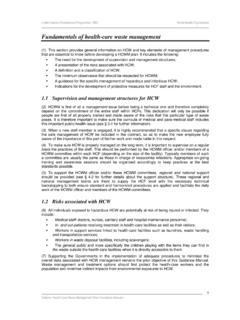Transcription of MANUAL FOR BIOMEDICAL WASTE MANAGEMENT
1 GOVERNMENT MEDICAL COLLEGE & HOSPITAL-32, CHANDIGARH MANUAL FOR BIOMEDICAL WASTE MANAGEMENT MANUAL FOR BIOMEDICAL WASTE MANAGEMENT Authors: Prof. Ravi Gupta, MS (Orthopedics), DNB, FRCS, FACS, FAMS, FIMSA Medical Superintendent Prof. Sanjeev Palta, MBBS, MD (Anaesthesia) Joint Medical Superintendent. Dr. Sonali Shamdasani, MBBS, DNB (Health & Hospital Administration) Senior Resident, Department of Hospital Administration. Preface Hospitals generate substantial quantity of wastes that has potential to cause health and environmental hazards.
2 In order to streamline the WASTE collection, processing and disposal practices, the Government of India has been revising the rules from time to time. On March 28, 2016, the Government of India published the BIOMEDICAL WASTE MANAGEMENT Rules, 2016 in supersession of the BIOMEDICAL WASTE ( MANAGEMENT and Handling) Rules, 1998. In the new BIOMEDICAL WASTE MANAGEMENT Rules, 2016, several changes and additions have been made to further improve the collection, segregation, processing, treatment and disposal of the BIOMEDICAL wastes in an environmentally sound manner. Under the new regime, the coverage has been increased to include vaccination camps, blood donation camps, surgical camps etc.
3 And also provision for pre-treatment of lab WASTE , blood samples, etc. It has simplified the process of categorisation of WASTE and authorisation. The rules clearly delineate the duties of occupier healthcare facility and operator of common BIOMEDICAL WASTE treatment facility. In the public interest, the BIOMEDICAL WASTE MANAGEMENT rules, 2016 have been further amended on March 28, 2018 as Bio-Medical WASTE MANAGEMENT (Amendment) Rules, 2018 . The BIOMEDICAL WASTE poses risk of hazards due to sharps, recycling of disposables, air, water, soil pollution etc. This requires spending of so many resources in terms of money, manpower, material and machine for MANAGEMENT of hospital WASTE .
4 All officials, medical, paramedical staff, attendants, safaikaramcharis and also general public should be well oriented to the BIOMEDICAL WASTE MANAGEMENT rules so that adverse effects to human health and environment are avoided. Thus, this MANUAL aims at elucidating the BIOMEDICAL WASTE MANAGEMENT rules, 2016 and its salient features, along with Bio-Medical WASTE MANAGEMENT (Amendment) Rules, 2018. The MANUAL also entails need to follow the rules and how the WASTE generated from all over the hospital is handled in our hospital (GMCH). It is not only important for efficient patient care but also has legal implications.
5 Prof. Ravi Gupta, Medical Superintendent Acknowledgement The BIOMEDICAL WASTE MANAGEMENT MANUAL will remain incomplete without expressing gratitude to the contributors of
6 This MANUAL as well as the hospital staff who have made implementation of the rules possible. Worthy Medical Superintendent was the first to envisage the idea of this MANUAL , with the vision that each and every staff of GMCH should be aware of the BIOMEDICAL WASTE MANAGEMENT rules and how the WASTE is being handled at GMCH. Thus, we are grateful to him for conceptualising the idea and his leading contribution in converting idea into reality. Heartfelt gratitude for Joint Medical Superintendent who has always been there for providing guidance at all stages while framing of the MANUAL . Gratitude is also expressed to Dr. Ashwani Dalal, Dy. Medical Superintendent III, who has taken the responsibility of monitoring the activities of BMW and is handling challenges faced during BIOMEDICAL WASTE MANAGEMENT dexterously making the correct application of rules possible.
7 The Department of Hospital Administration has always been at the forefront of implementation of the rules. The contribution of hospital administration by keeping the staff updated about the rules through training classes conducted time to time, taking corrective actions if anything found wrong during rounds, displaying of the poster in all areas of the hospital etc. is significant. Nevertheless, contribution of Nursing Superintendent has been considerable in managing such a large cadre of nursing staff and ensuring that the WASTE is being handled in a proper manner. The work of Ms. Navjot, ANS Incharge BMW is also appreciated who has been supervising the activities of BIOMEDICAL WASTE MANAGEMENT meticulously.
8 Thanks to Ms. Mamta, Incineration Supervisor for all the help she has provided towards the formulation of this MANUAL and also for taking the pain in managing day to day activities in BIOMEDICAL WASTE MANAGEMENT . Lastly, we thank all the hospital staff who are working day and night in various areas of the hospital for providing efficient and effective patient care during which they have been giving their valuable contribution in BIOMEDICAL WASTE MANAGEMENT . We hope this MANUAL will be of help for all the hospital staff. Dr. Sonali Shamdasani Senior Resident, Admin. TABLE OF CONTENTS 1. Government Medical College & Hospital, Chandigarh: A Brief 1 2.
9 BIOMEDICAL WASTE MANAGEMENT : An 2 3. Need of BIOMEDICAL WASTE 3 4. Landmark decisions to streamline hospital WASTE 4 5. Bio-Medical WASTE MANAGEMENT Rules, 6 6. BIOMEDICAL WASTE MANAGEMENT at 15 7. Responsibilities of various categories of 24 8. 25 Annexure I: Form I-Accident 25 Annexure II: List of prescribed authorities and the corresponding 26 Annexure III: Segregation list of common items in hospital as per bio-medical WASTE MANAGEMENT rules 2016 (English and Hindi).. 30 9. 32 GOVERNMENT MEDICAL COLLEGE & HOSPITAL, CHANDIGARH: A BRIEF OVERVIEW GMCH was established in the year 1991 as a medical college with intake of 50 MBBS students and 500 bedded hospital.
10 Due to high quality medical care and medical education, GMCH has made a niche in the region and has emerged as a highly popular institution. It is ranked in the first 10 Government Medical Colleges of the country with present intake of 100 MBBS students and 122 postgraduate students every year. GMCH caters not only to patients from Chandigarh but also patients hailing from the surrounding states of Punjab, Haryana, Himachal Pradesh, Jammu and Kashmir and Rajasthan. There has been rise in number of beds from 500 in year 1991 to 813 beds at present. GMCH is providing not only specialist care but also super speciality services like Neurosurgery, Neurology, Cardiology, Urology, Gastroenterology, Endocrinology, Nephrology etc.









